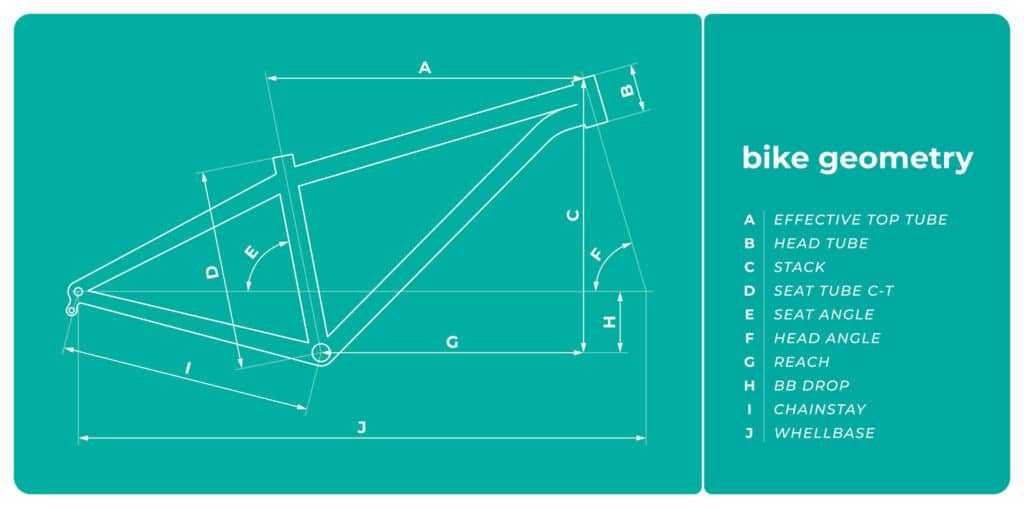If you didn’t pay attention in 10th grade math, that’s ok. Geometry isn’t the most exciting thing in the world, but without it, you’d be riding down the mountain on a penny farthing. While we won’t be talking about the Pythagorean Theorem or a parabola, there will be plenty of talk about angles. Although mountain bike geometry may sound technical, it’s the foundation of how your bike handles, feels, and performs.
By understanding the key elements of geometry, you can find a bike that’s perfectly suited to your riding style and favorite trails. In this guide, we’ll clear up the mystery behind mountain bike geometry, so when you’re reading descriptions about slack and steep angles, you’ll know exactly what it means.
The Building Blocks of Mountain Bike Geometry
Every part of a bike’s geometry plays a role in how it performs. From how stable you feel at high speeds to how nimble your bike is on switchbacks, it all comes down to a few key factors.
Head Tube Angle: Stability vs. Agility
Have you ever wondered why some mountain bikes feel rock-solid on downhill runs while others are twitchy and quick to turn? The head tube angle is the culprit.
- A Slack Head Tube Angle (more laid-back) creates stability, perfect for downhill bikes that prioritize control at speed on steep, rough terrain.
- A Steep Head Tube Angle (more upright) offers quick, sharp handling—ideal for cross-country (XC) riders weaving through tight trails.
Seat Tube Angle: Power and Efficiency
The seat tube angle determines the position of your saddle in relation to the pedals, and it plays a big role in your pedaling efficiency and comfort. A well-balanced seat tube angle ensures that you can ride efficiently uphill without sacrificing comfort on the way back down.
- A Steep Seat Tube Angle (closer to vertical) is ideal for climbing, as it positions you directly over the pedals for maximum power transfer. This is common in cross-country and trail bikes designed for tackling steep ascents. Enduro bikes are also using steeper seat tube angles to help with climbing since a dropper post can make that seat disappear when you’re ready to head downhill.
- A Slack Seat Tube Angle (more laid-back) shifts your weight slightly backward, providing more comfort and stability on descents. You’ll often find this on downhill oriented bikes.
Wheelbase: The Stability Trade-Off
Think of the wheelbase as your bike’s foundation. A longer wheelbase makes your ride feel planted and steady, especially at speed. On the flip side, a shorter wheelbase gives you razor-sharp agility for navigating tight technical sections, but at the cost of stability when you’re going fast.
Reach and Stack: Fit and Comfort
Reach measures how stretched-out you’ll feel on the bike. A longer reach suits riders who love speed and stability, while a shorter reach keeps you upright and comfortable.
Stack affects your posture. A taller stack creates an upright position, great for casual trail rides, while a lower stack puts you in a more aggressive stance for attacking climbs and descents.
Chainstay Length: The Back-End Effect
This is the distance between the pedals and the rear wheel. Short chainstays make your bike more playful and easier to whip around corners. Longer chainstays, on the other hand, improve climbing traction and stability.
Fork Offset (Rake): Steering Precision
Fork offset tweaks the front-end geometry to affect handling. A shorter rake keeps steering steady and predictable, while a longer rake makes the bike more responsive to quick turns.
Mountain Bike Geometry Made Simple
Understanding these elements isn’t just for gearheads—it’s essential knowledge for anyone who wants their bike to feel just right. Mastering mountain bike geometry is the key to finding a bike that feels like an extension of yourself. Whether you’re chasing speed, stability, or snappy handling, the right geometry can make every trail more fun. It’s the secret sauce to how your bike rides and feels, and knowing how it all fits together is crucial for picking the perfect bike.
If it all still seems like black magic, no worries. Just stop by our Castle Rock or Denver mountain bike shop to speak with our team of experts. We’ll help you find the perfect bike for your style and favorite trails.

